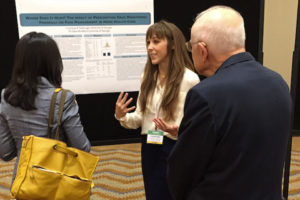
Ph.D. student, Courtney Yarbrough presented her paper, “State Policies to Curb Opioid Abuse Lead to Improved Pain Outcomes for Medicare Home Health Patients,” coauthored with Dr. David Bradford at the APPAM Fall Research Conference which took place November 6-8, 2014 in Albuquerque, NM. Read below for the abstract to Yarbrough’s paper.
As states pass regulations to curb opioid abuse, what are the consequences for legitimate pain management? Forty-nine states have adopted prescription drug monitoring programs (PDMP) to detect potentially inappropriate opioid prescribing and use. Several studies have estimated the impact of PDMPs in reducing abuse and deaths. However, no study addresses an equally important question—do PDMPs generate negative or positive spillover effects for pain management in the millions of Americans suffering from chronic pain? We use 2003-2010 home health agency-level panel data to assess the effect of PDMPs on pain improvements in home health patients. We hypothesize that implementation of a PDMP may induce agencies to substitute away from opioids to other (potentially more effective) treatments, such as physical therapy. Using a fixed effects, two-stage least squares model, we estimate pain improvements as a result of whether a state has implemented a PDMP and control for endogeneity between state policies and pain management practices. We find that agencies in states with PDMPs are on average more successful at improving pain in their patients; however, the effect varies according to how the agencies are reimbursed for services through Medicaid. Our results suggest that home health agencies are adapting their models of care to state opioid policies, and the incentives embedded in reimbursement systems can either promote better or worse pain management.








